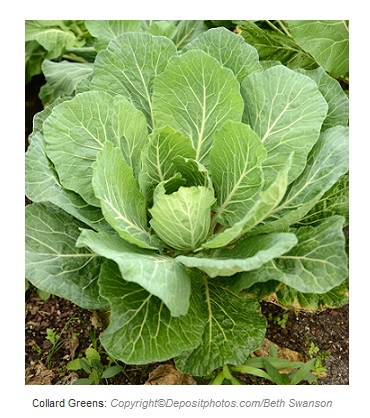Collard is a green leafy vegetable from brassica family and is closely related to kale and  mustard greens. Every 100 grams of collard contains 6 grams of carbohydrates, 4 grams of fiber and 2 grams of protein.
mustard greens. Every 100 grams of collard contains 6 grams of carbohydrates, 4 grams of fiber and 2 grams of protein.
Average calories: 32 per 100 grams.
|
Collard Greens: 100 grams |
|
|
Carbohydrate |
6 |
|
Fiber |
4 |
|
Protein |
2 |
|
Fat |
0 |
|
Calories |
32 |
Vitamins found in higher amounts: vitamins K, A, C, B9 and E. Every 100 grams of collard provides 510 mcg of vitamin K and 6670 IU of vitamin A.
Minerals found in higher amounts: calcium, manganese, potassium and magnesium.
Phytonutrients found in higher amounts and their health benefits: like other brassicas, collard contains certain phytochemicals and they include indole-3-carbinol, diindolylmethane, sulforaphane, isothiocyanates, and carotenoids.
Indole-3-carbinol is a phytonutrient that can reduce risk of developing estrogen-related cancers by altering the metabolism of estrogen. Indole-3-carbinole is also found in cabbage, cauliflower, Brussels sprouts, kale and broccoli.
Diindolylmethane (DIM) comes from the breakdown of indole-3-carbinol in the body and has anti-viral, anti-bacterial, anti-androgenic, anti-inflammatory, and anti-cancer properties. DIM interferes with the blood supply of the tumors, making them shrink. In other words, DIM has an anti-angiogenesis effect. It is also a potent antiviral and antibacterial agent.
Sulforaphane can inhibit the growth of Helicobacter Pylori, a microbe responsible for peptic ulcer and stomach upset. Sulforaphane is also found in Bok Choy,Brussels sprouts, cabbage, cauliflower, kale, broccoli, kohlrabi, mustard greens, turnip, radish, arugula, and watercress. It has an anti-cancer activity as well.
Isothiocyanates induce apoptosis (programmed cell death) in certain cancers. However, the downside of isothiocyanides is that they interfere with uptake of iodine, leading to goiter (enlargement of thyroid gland).Isothiocyanates can enhance liver detoxification by stimulating both phase I and phase II of detoxification process.
Beta-carotene, lutein and zeaxanthin are the carotenoids found in collard greens. They are antioxidants with protective effects on the eyes.

